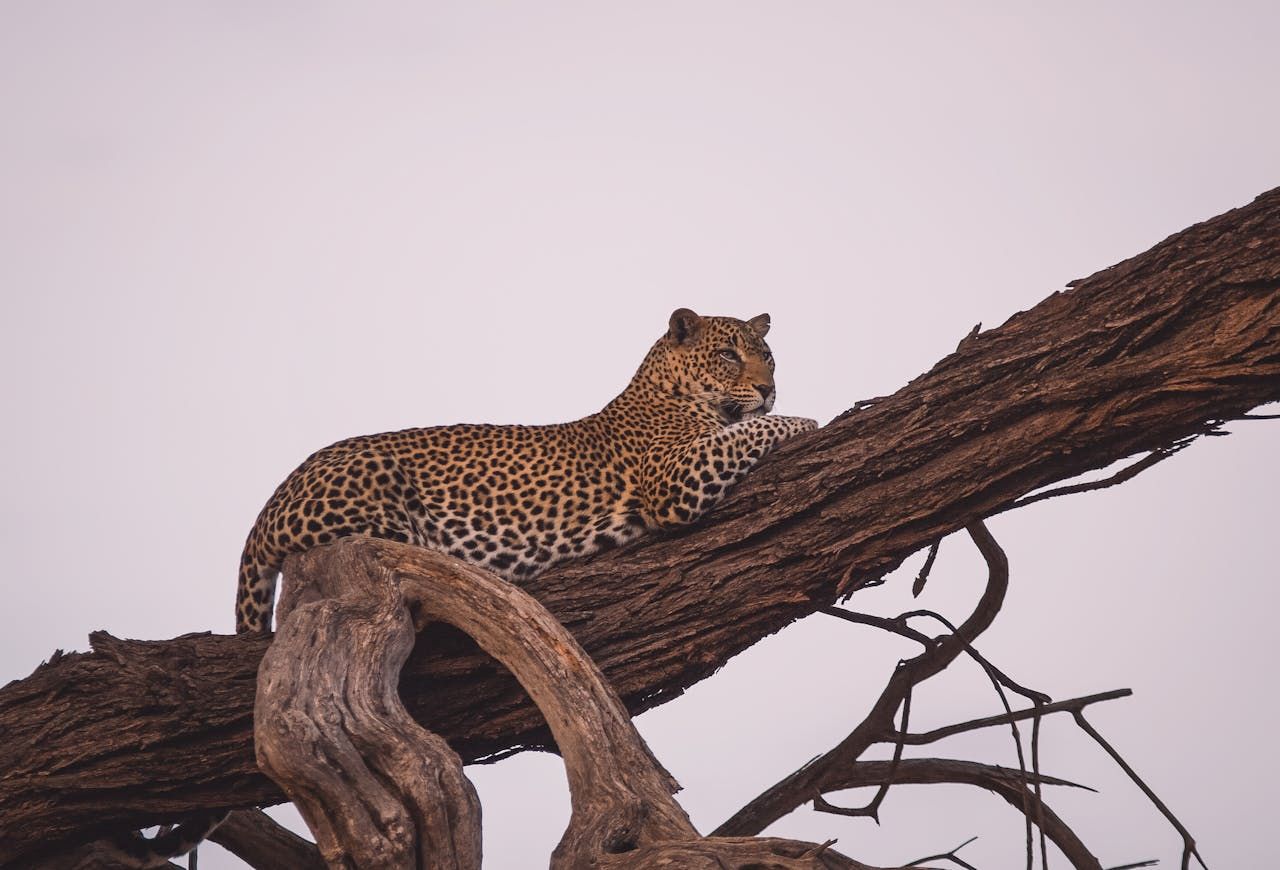Elusive. Dangerous. Cunning. Carnivorous. Nocturnal. Solitary.
These are just a few adjectives describing one of Africa’s and the world’s most stunning apex predators and a sought-after target for dangerous game hunters. Leopards are members of the African cat family and have been hunted for centuries. They are a popular and sought-after game hunting trophy for many hunters worldwide. Find out more about what makes this nocturnal predator such an exciting and challenging African hunt.
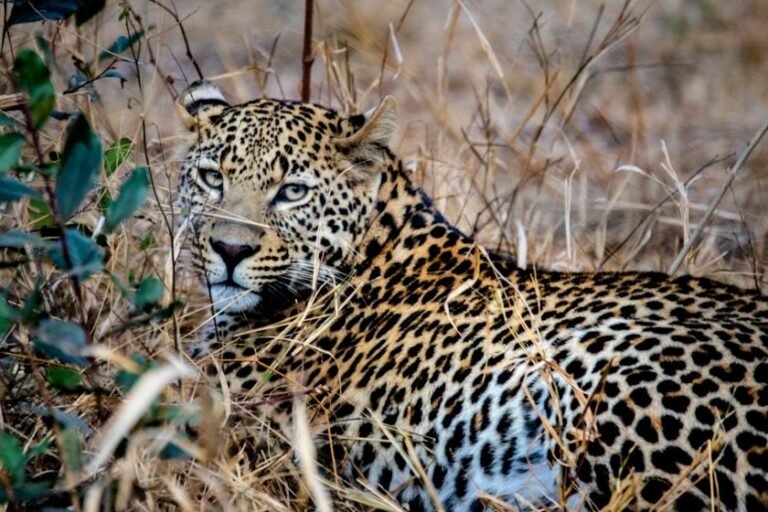
[DYNAMIC-BLOGTABLEOFCONTENT]
Key Takeaways
- The leopard is a sought-after dangerous game hunting target that mainly inhabits sub-Saharan Africa.
- While they prefer savannas, deserts, grasslands, and mountains, they are highly adaptable in terms of habitats.
- They are exceptionally agile African cats, who prefer their solitude.
- They are mainly nocturnal and they are experts at camouflaging themselves.
- Each leopard’s coat is unique, covered in dark spots called rosettes.
- Leopards are often targeted for their exceptional coats.
- The IUCN has listed the leopard’s conservation status as vulnerable, due to its worldwide declining numbers.
- Leopard hunting safaris take place throughout sub-Saharan Africa, including Zambia, Botswana, Tanzania, Namibia, Zimbabwe, and Mozambique.
- Although leopard hunting is legal in South Africa, no tags have been issued for a couple of years already.
- Your leopard hunting method will depend on your hunt’s location, as well as the local rules and regulations, conservation laws, as well as the hunter’s experience and preference.
- Some destinations, such as Mozambique and Zimbabwe, may include leopard hunting with hounds.
- Leopard hunting requires patience, perseverance, and excellent shot placement to successfully target this cunning and elusive African cat.
The African Leopard
At A Glance
Scientific Name: Panthera pardus pardus
Weight (Adult Male): 80-195 pounds
Regions: Mostly sub-Saharan Africa
Preferred Habitat: Mountainous forests, savannas, deserts, and grasslands
An Overview
The leopard is a nocturnal African cat, living in various habitats including deserts, semi-deserts, savannas, grasslands, and even rainforests. Their ability to survive and thrive in such varied habitats shows how exceptional these solitary animals are and their ability to adapt is inspiring. Although mainly nocturnal, you may be lucky enough to spot them in the day.
Male leopards are larger than their female counterparts, reaching up to 195 pounds compared with the more petite females who weigh around 120 pounds.
An African leopard’s coat colors range from golden-yellow to a tawny color. An interesting fact about their coats is that each leopard’s coat is unique. It is covered in spots called rosettes that vary in size and shape, creating a pattern unique to that specific leopard. The animal’s head, shoulders, and neck have denser rosettes while the remainder of the body has larger and less densely spaced spots. Both the rosettes and the color of their fur assist leopards in being able to camouflage themselves from other predators, as well as hiding while waiting for prey to appear. As you can see from the image below, the rosettes are quite striking and form a beautiful coat.
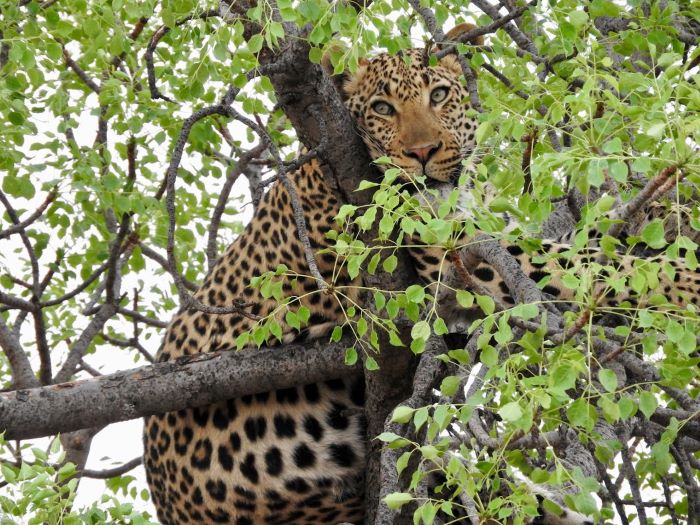
This coat is one of the reasons why they are targeted on leopard hunts in Africa. Many international game hunting enthusiasts are eager to have this spectacular animal on show in their trophy room, while some local tribes utilize the coats in tribal ceremonies. These animals may also be targeted due to human-wildlife conflict, or perhaps the poaching of local livestock. Whatever the reason, the number of African leopards is declining.
For me, a leopard is very much an all-rounder predator, so to speak. Not only can this cat reach impressive speeds of up to 36 miles per hour to chase down antelopes across the savanna, but they are extremely agile and can climb trees with ease. I have watched videos where the antelopes are grazing peacefully below a tree, blissfully unaware of the danger lurking overhead, only for the leopard to run down the tree and pounce on its chosen prey. They didn’t stand a chance, and although there was a piece of me that felt immensely sorry for the antelope, I could not help but be impressed by the leopard’s impressive hunting skills. I am guessing that’s where the cat side of the leopard comes to the fore, as it uses the trees to hide from predators, hide out, lie in wait for prey, or even store prey from other sneaky predators who wouldn’t think twice to steal a meal. However you look at it, the leopard is an exceptional predator!
As expected, in line with their habitats, leopards have a varied diet. From catching fish in rivers to hunting antelopes such as the impala across the savanna, and enjoying some fresh baboons or even porcupines, leopards show their range of hunting skills across the African veld.
Conservation Status
The International Union for the Conservation of Nature (IUCN) lists the species as “vulnerable,” showing a decline in numbers worldwide. For the African leopard, this could be for various reasons such as declining habitats, less prey, and climate change (although this African cat is highly adaptable in terms of habitat). CITES has issued quotas of 2,518 leopards that may be harvested during 2024.
Fun Facts about the Leopard
- Leopards are the smallest of Africa’s Big 5.
- They are nocturnal and have seven times better eyesight than humans at night.
- They are solitary creatures.
- A group of leopards is called a leap.
- A leopard’s spots are called rosettes and assist them in camouflaging themselves in the bush. The rosettes assist the leopards in having a unique coat, not one is the same.
Which are the Best Destinations for Leopard Hunts in Africa?
The African leopard is found throughout sub-Saharan Africa, and there have also been sightings of this elusive predator in northern Africa. Leopards are found throughout diverse and changing habitats, with varying ecosystems and wildlife within them.
Leopard hunting safaris take place in various African countries, including Mozambique, Zimbabwe, Namibia, Botswana, Tanzania, and Zambia. No tags have been issued by South Africa’s government for leopards in the last couple of years.
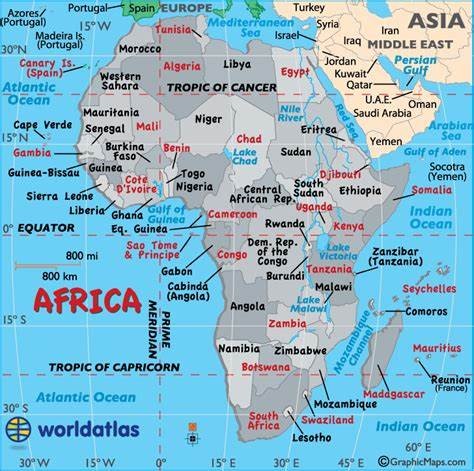
Mozambique
Mozambique is a firm favorite destination for leopard hunting in Africa, with its rugged and untamed landscapes just calling hunters to enjoy a leopard hunting safari! With some of the highest leopard populations on the continent, Mozambique is ticking the boxes as a prime dangerous game hunting destination.
Popular leopard hunting locations in Mozambique include the Zambezi Delta to the north of the country, rich in water reserves and sports lush, green vegetation. Tete province, near Lake Cahora Bassa, is renowned for its large and impressive leopard trophies, while the Niassa Reserve is also a prime leopard hunting destination.
The best time for leopard hunting in Mozambique is from May to October, during the region’s dry season, when animals are more likely to be closer to water and grasses are shorter, allowing hunters to see their targets more easily. A popular method allowed when leopard hunting in Mozambique is the use of hounds to track and corner the leopard, allowing for an exciting and unusual hunting safari! These are not allowed in all hunting destinations, but they do make for an exciting hunting adventure.
Zimbabwe
Another prime destination for leopard hunting, Zimbabwe is a country rich in wildlife, including this infamous member of Africa’s Big 5. When it comes to timing, the best time of the year for leopard hunts is during the winter months (June-August), with an additional tip to hunt during the dark phase of the moon.
Professional hunters tend to book leopard hunting in Zimbabwe during the dark phases of the moon for several reasons including:
- Increased visibility: Less ambient light allows the leopard to be more easily spotted, resulting in an easier time while hunting leopards in Zimbabwe.
- Baiting: Leopards are more likely to visit the bait station during the dark phases of the moon.
- Reduced Movement: Leopard movements are more localized during this time.
- Precision Shot Placement: Leopard hunts require exceptional shot placement, and the reduced moonlight, together with an excellent scope, minimizes the risk of startling the leopard while approaching and allows for better accuracy.
Leopard hunting can take place during daylight hours in certain areas, but only 30 minutes after sunrise and 30 minutes before sunset. Leopard hunts at night are legal on private and community land, with special permits being necessary to use hounds during the hunting safari.
Hunts can be enjoyed throughout the country, except in the plateau region, with popular spots for leopard hunts including the Zambezi River Valley, Matobo Mountains, and various national parks, such as Matetsi National Park. The terrains are varied, including mountains, savannas, forests, and grasslands, allowing the hunter to choose the location of his leopard hunt, depending on the habitat he wishes to hunt in.
Botswana
The best time to target this nocturnal predator on an African leopard hunt is during the cooler months of July to September. Some of the best trophy leopards have been harvested from Botswana‘s Okavango Delta and the Kalahari Desert. Two such differing habitats of the arid landscape versus lush vegetation where this cunning predator thrives once again show the leopard’s amazing adaptability.
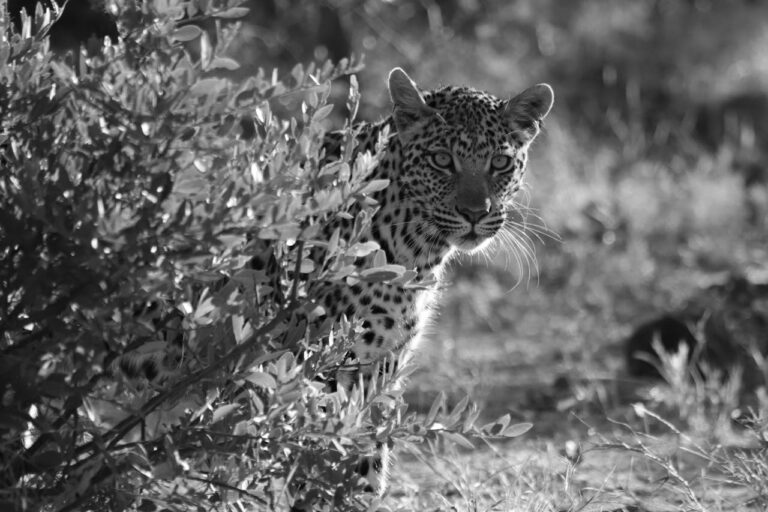
Tanzania
Without a shadow of a doubt, Tanzania is one of the best destinations in which to enjoy leopard hunting or many game hunting safaris. These include dangerous game hunting or specialty hunts, and let’s not forget the mesmerizing and diverse range of African plains game that call Tanzania home! With close to three-quarters of the country’s landscape being wilderness areas, consisting of national parks, hunting areas, and game reserves, the area abounds with wildlife, giving the hunter the thrill of a free-range leopard hunting safari. Most areas are also unfenced, allowing the hunter the thrill of a free-range African leopard hunting safari.
Popular leopard hunting areas in Tanzania are Masailand, Rungwa, and Maswa, as well as the world-renowned Selous Game Reserve, which sees one of the country’s largest concentrations of trophy leopards.
Leopard hunting in Tanzania peaks from June through to August, during the area’s drier months.
South Africa
When it comes to dangerous game hunting, this country on Africa’s southernmost tip is alive with wildlife and hunting opportunities. Limpopo is known as South Africa’s game hunting capital so to speak, and leopard hunting is no different. The area’s Waterberg Mountains are a popular location to hunt this sought-after trophy, providing hunters with a challenging hunting adventure best enjoyed during the cooler winter months of June to August.
While hunting leopards is legal in South Africa and CITES quotas confirmed, no tags have been issued for the past couple of years. Check with your African outfitter for the latest information about leopard hunting in South Africa.
Zambia
This landlocked African wildlife treasure chest is just that: An African wildlife treasure, just waiting to be explored by hunters in search of the perfect target. Zambia is one of Africa’s prime leopard hunting destinations, with a top spot for hunts being the famous Luangwa Valley.
The area provides a real African backdrop, with lush vegetation, plenty of antelopes on the plains, and the Luangwa River that flows through the area. With ample prey, plenty of water, and a pristine habitat, it is no wonder that leopards have taken up residence here.
Namibia
Namibia offers dangerous game hunters the best of both worlds in terms of terrain, with popular locations for leopard hunts including the Erongo Mountains and the Kalahari, with its rugged terrain.
In terms of timing, the optimal hunting season for leopards in Namibia would be during the colder winter months, from around June to August.
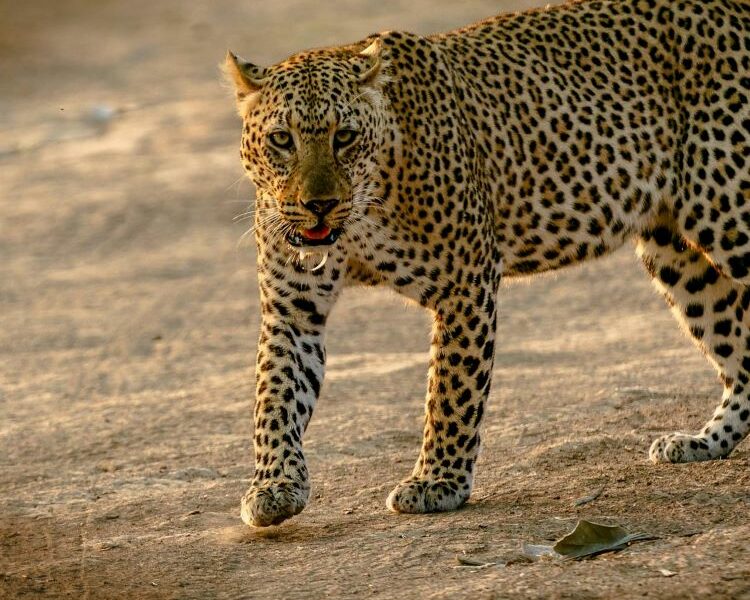
Hunting Methods & Techniques for Your Leopard Hunting Safari
When preparing for leopard hunting in Africa, do yourself a favor and prepare for the unexpected. Even the best-planned hunt can go pear-shaped, resulting in a challenging and potentially dangerous situation. Do all you can to adequately prepare yourself for your leopard hunting adventure, by researching this dangerous African predator’s anatomy and the best shot placement options. And yes, a leopard is extremely dangerous and is known to be one of the most dangerous animals alive when wounded.
On that note, ensure that your shot placement is exceptional. Unless you are 100% sure, don’t take the shot. In this case, tracking a wounded leopard through what might be dense bushveld is not a good idea, especially with an apex predator that has excellent camouflage skills, and the ability to climb trees easily.
Your leopard hunting method may vary depending on your hunt’s location, local regulations, the hunter’s experience, and conservation laws.
The most common method of targeting the leopard is the baiting method. A carcass of an antelope, usually an impala, or springbok, is placed where leopard toms are known to be frequent or have been seen. A blind is set up and the wait starts for the animal to approach. Once within striking range, and a good shot placement angle is achieved, the hunter will take the shot.
In some African countries, such as Mozambique and Zimbabwe, leopard hunting can include hounds. The hounds, along with the tracker, track the leopard and corner it, then allow the hunter to take the shot.
Lastly, another option that is not widely used and not too successful due to the leopard being such an elusive and difficult animal to stalk is the walk-and-stalk method. Tracks are found and followed.
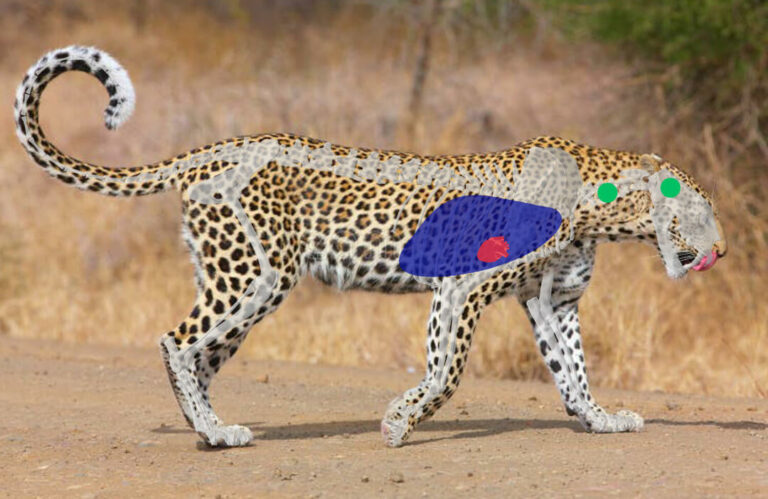
Frequently Asked Questions
Where in Africa can I hunt leopards?
Zimbabwe, Mozambique, Namibia, Tanzania, and Botswana are known as excellent leopard hunting destinations.
Are leopards difficult to hunt?
As one of Africa’s Big 5, the leopard is seen as one of the most challenging animals to target on an African hunt. While typically being hunted using baits and blinds, some countries also allow the use of hounds. These African cats have exceptional camouflage skills, and sharp reflexes, and are both agile and very elusive, making for a challenging hunting safari!
How much does it cost to hunt leopards in Tanzania?
Leopard hunting can be undertaken in many African countries, with Tanzania being one of them. While there are more affordable options available, leopard hunting in Tanzania can reach more than US$100,000 for a 21-day hunt. It must be said, however, that Tanzania remains one of the most sought-after destinations to enjoy a leopard hunt, offering clients a truly unforgettable leopard hunting experience.
How long do leopards live?
Leopards can live up to 12 years in the wild, while those in captivity have been known to live for longer than 20 years.
Are leopards nocturnal?
Yes, leopards are nocturnal. These members of the cat family, along with many other cats, are nocturnal. Leopards are active and hunt at night, using daylight hours to sleep and rest.
Are leopards aggressive?
Yes, leopards are very aggressive, especially when cornered or wounded. Wounded leopards are seen as the most dangerous animal worldwide. Leopards are seen as one of Africa’s fiercest animals.
Can leopards climb trees?
As members of the cat family, leopards are very agile and can climb trees with ease. They use trees to hide and wait for prey, as well as hide from danger and predators.
What do leopards like to hunt?
As a large carnivore, leopards hunt a range of animals. These include rabbits, warthogs, antelopes such as impala, springbok, and wildebeest, as well as baboons, monkeys, and even porcupines.
How does a leopard kill its prey?
Prey is grabbed or swatted with its powerful paws and retractable claws, after which the prey is killed by biting its throat and suffocating it. Large prey is then carried up a tree, to keep it safe from other predators.
Leopard Hunts in Africa: A Bucket List Activity
I believe that certain hunts are just once-in-a-lifetime activities, where even if you must do the same hunt again, in the same place, it will just not live up to that first African hunting adventure. Leopard hunting safaris are one of those.
They are enthralling, nerve-wracking, dangerous, and a challenge to every hunter who has ever experienced them! They are, most certainly, a bucket list item.
I mean, where else would you skulk in the shadows, under the African night sky, and hunt one of the most notorious predators known to man? Leopard hunting expeditions are thrilling, gut-wrenching, and adrenaline-filled days and nights where all you can think, eat, and dream about is your trophy animal, with its gorgeous, patterned rosettes! And when your patience has been rewarded with an exceptional specimen and you take the shot, the victory – and trophy – is yours.
Come to Africa and book that leopard hunting adventure. You will not be disappointed.
Author: B. Hershensohnn
